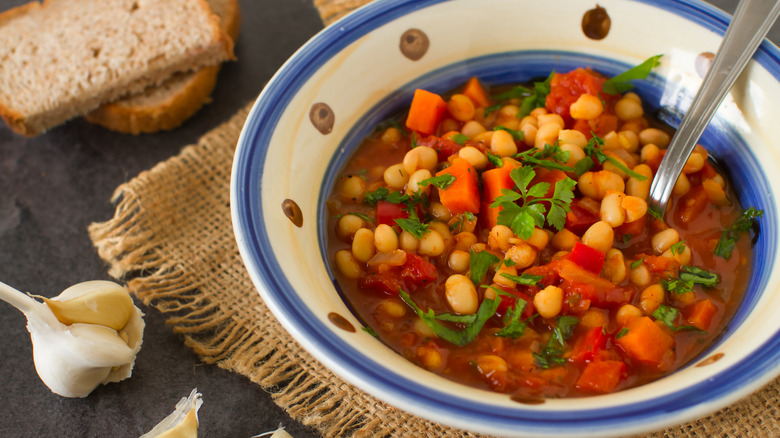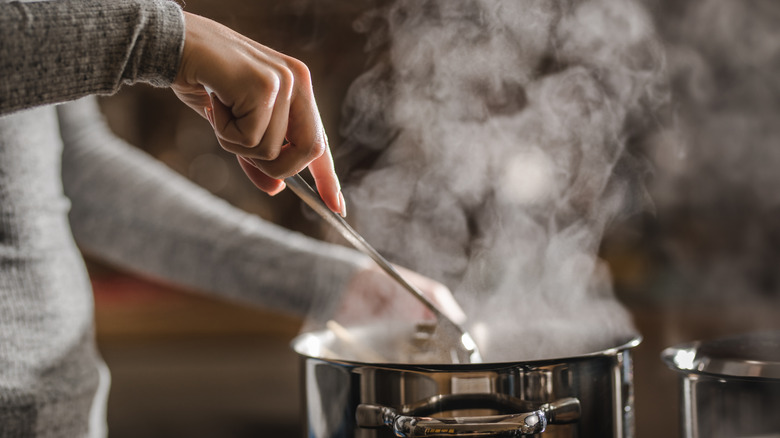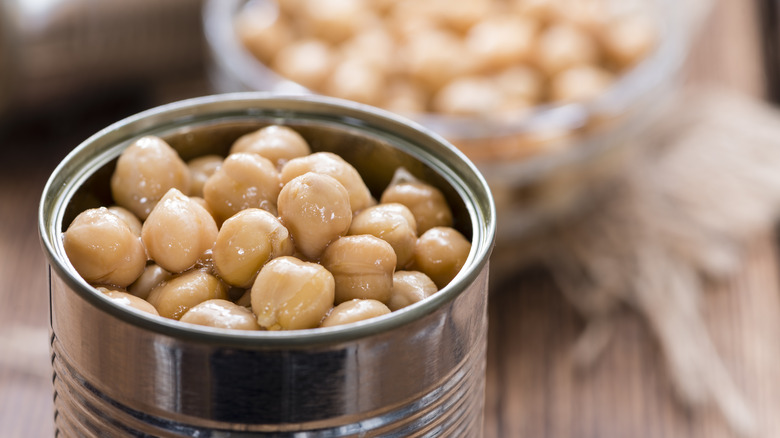The Only Tip You Need To Make Great Soup From Canned Beans
It's hard to think of a staple food more versatile, nutritious, affordable, or universally enjoyed and beloved than the humble bean. No matter your dietary style, eating habits, culture, or experience level as a cook, if you have a can opener and a variety of canned beans in your pantry, you're minutes away from being able to whip up a range of delicious and filling recipes.
Before it was trendy to use beans in innovative, creative, outside-the-box ways (white bean blondies or vegan chickpea salad, anyone?), one of the most time-honored and back-to-basics ways to use a can of legumes has been simply to pop one open and add to almost any soup or stew. This is a tasty option for anything from a chile to a minestrone to a slow cooker tortilla soup. While it's true that you can always simply grab a can opener and dump beans straight into the pot of soup you have on the stove — and no judgment there — taking just a bit of extra time and attention pays off in terms of more flavorful, well-balanced soups. So next time you're making your favorite quick weeknight dinner, instead of adding beans at the very end of the cooking process when you're only a few minutes away from being ready to eat, add your beans earlier in the process. The longer they have to simmer and mingle with the other ingredients — broth, spices, veggies, proteins — the more flavor they'll take on and the richer and more harmonious the end result will be.
Let beans simmer for half an hour for max flavor
When making any soup with canned beans, aim to give them around 30 minutes to simmer down with the other ingredients. That's the not-too-little, not-too-long, but just-right amount of time they need to cook down and pick up the flavors of the recipe without becoming soggy or overcooked. The result will be a balanced bowlful with well-incorporated seasoning in every bite — versus a soup with beans that taste like an afterthought. Again, no judgment here if you're routinely opening canned chickpeas, draining, and tossing them onto a salad — that gets the job done just fine. But when using canned beans in cooked dishes such as soups, cut corners elsewhere — and let beans cook.
And if you're wondering if you need to drain and rinse canned beans before using them — an oft-repeated tip in most recipes and articles involving the ingredient — consider that as advice rather than absolute gospel. It's true that in many cases, your best bet is to rinse away the included liquid from the can, which can include unwanted sodium, additives, and a slimy texture you may prefer to rinse away. But the liquid inside a can is also packed with the starch from the beans themselves, which can help thicken up a saucy pot of black bean soup for example. So whether to rinse depends on your preference. And you should never get rid of the liquid from canned beans — set it aside to use later in a host of creative recipes and shortcuts.
Canned beans don't have to be bland
There are two basic methods for adding beans into your diet: Popping open a can of beans that have already been commercially blanched, cooked, and preserved — no doubt the easiest and quickest option — or taking the time to give dried beans an overnight soak and then cook down, which often requires hours and plenty of planning ahead. One method is not objectively better than the other — it all comes down to personal preference and the time you have. Though the dried route will save you a bit of money , at the end of the day, beans are an affordable, nutritional powerhouse no matter how you're buying and consuming them, and if popping open a can is what works for your busy schedule, then by all means, carry on.
When it comes to taste, though, the jury is in, and the more time-consuming method of soaking and cooking dried beans does yield a richer, more flavorful final product. If you've ever assumed canned beans taste a little on the bland side by nature, or been shocked at the difference when trying dried beans that have been methodically cooked for hours, implementing this tip helps make up the difference. While cooked canned beans likely won't ever achieve quite the same flavor and richness of the slow-cooked dried variety, every minute helps to enhance and amplify their flavor.


